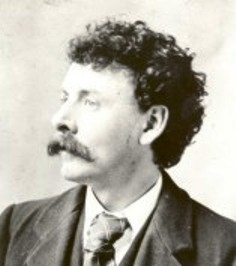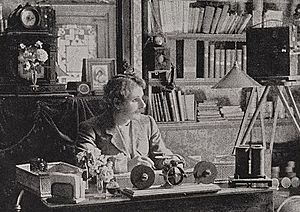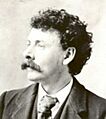George Albert Smith (filmmaker) facts for kids
Quick facts for kids
George Albert Smith
|
|
|---|---|

George Albert Smith in 1902
|
|
| Born | 4 January 1864 London, England
|
| Died | 17 May 1959 (aged 95) |
| Occupation | Film maker, inventor |
George Albert Smith (born January 4, 1864 – died May 17, 1959) was an English inventor and filmmaker. He was a very important person in the early days of movies. He helped create new ways of making films, like using editing and close-ups. He also developed the first successful way to make movies in color, called Kinemacolor.
Contents
George Albert Smith's Early Life
Birth and First Jobs
George Albert Smith was born in Cripplegate, London, in 1864. His father, Charles Smith, was an artist. After his father passed away, George and his family moved to Brighton. There, his mother ran a boarding house.
In the 1880s, George became known for his stage shows. He performed as a stage hypnotist in Brighton. In 1882, he worked with Douglas Blackburn at the Brighton Aquarium. They did acts where George seemed to have special abilities, like finding hidden objects while blindfolded.
Working with the Society for Psychical Research
George's shows caught the attention of the Society for Psychical Research (SPR). This group studied unusual mental abilities. George became a member and worked as a private secretary for Edmund Gurney from 1883 to 1888. They did "hypnotic experiments" together.
Later, Douglas Blackburn said that their acts were not real and were just tricks. George Albert Smith, however, always said they were genuine.
Becoming a Film Pioneer
St. Ann's Well Gardens
In 1892, George took over St. Ann's Well Gardens in Hove. He turned it into a fun park for people to visit. He had hot air balloon rides, parachute jumps, and even a monkey house. He also showed "magic lantern" shows. These shows used slides and light to tell stories. George was very good at changing slides quickly to show different scenes. This skill helped him later when he started making movies.
Starting in Film
George saw early movies in 1896. He was inspired by other filmmakers like Robert Paul. In 1897, he and a local chemist, James Williamson, got early movie cameras. They worked with Alfred Darling, who made film equipment.
George turned a pump house in the gardens into a "film factory." Here, he developed and printed films. He also invented his own camera and projector system. Both George and his neighbor, James Williamson, became important early filmmakers. They made many short films, usually about a minute long.
On March 29, 1897, George started showing "animated photographs" (movies) at the Brighton Aquarium. Many of his first films were comedies, like The Miller and the Sweep and Old Man Drinking a Glass of Beer (both from 1897). His wife, Laura Bayley, who was an actress, helped him with these funny ideas.
George also learned from Georges Méliès, a famous French filmmaker known for special effects. George's films like The X-Rays and The Haunted Castle (both 1897) used special effects. He even patented a way to create effects using double-exposure. This meant showing two images on top of each other.
Creative Film Editing
In 1899, George built a glass film studio at St. Ann's Well Gardens. This was a very creative time for him. He made a film called The Kiss in the Tunnel (1899). He then cleverly added it into another film to make it more exciting. This showed how editing could change a story.
He also experimented with new ideas:
- In The House That Jack Built (1900), he played film backwards.
- In Let Me Dream Again (1900), he used a "dissolve" effect, where one scene slowly fades into another.
- He was a pioneer in using the close-up. This is when the camera zooms in on a small detail. You can see this in his films Grandma's Reading Glass, As Seen Through a Telescope, and Spiders on a Web (all 1900).
These experiments helped create the basic rules of how movies are made today.
In 1902, George worked with Georges Méliès on a film about the Coronation of King Edward VII. This film was made because another company had the rights to film the real event. In 1903, Charles Urban, who distributed George's films, started his own company. This marked the end of George's most active period as a filmmaker.
Inventing Color Film
Developing Kinemacolor
In 1904, George moved to a new home called Laboratory Lodge in Southwick. With money from Charles Urban, he worked on developing a color film process. This process was called Kinemacolor.
Kinemacolor was the first successful color film process. It used two colors, red and green, to create the illusion of full color. George showed off this new process with films like Tartans of Scottish Clans (1906) and Woman Draped in Patterned Handkerchiefs (1908). He gave a public demonstration of A Visit to the Seaside (1908) in 1908. For this, he received a silver medal from the Royal Society of Arts.
In 1910, Charles Urban started the Natural Colour Kinemacolor Company. This company made over 100 short color films. However, in 1914, a legal case about the patent for Kinemacolor ended George's career in film.
Later Life and Legacy
In the late 1940s, the British film community remembered George Albert Smith's important work. He was made a Fellow of the British Film Academy in 1955. George died in Brighton on May 17, 1959. Today, the Hove Museum has a special exhibit about George Smith and James Williamson.
Selected Filmography
- The Haunted Castle (1897)
- Making Sausages (1897)
- Old Man Drinking a Glass of Beer (1897)
- The X-Rays (1897)
- The Miller and the Sweep (1898)
- Photographing a Ghost (1898)
- Santa Claus (1898)
- The Kiss in the Tunnel (1899)
- As Seen Through a Telescope (1900)
- Grandma's Reading Glass (1900)
- Grandma Threading her Needle (1900)
- Spiders on a Web (1900)
- The Old Maid's Valentine (1900)
- The House That Jack Built (1900)
- Let Me Dream Again (1900)
- The Inexhaustible Cab (1901)
- The Death of Poor Joe (1901)
- Mary Jane's Mishap (1903)
- The Sick Kitten (1903)
- Tartans of Scottish Clans (1906)
- Two Clowns (1906)
- Woman Draped in Patterned Handkerchiefs (1908)
- A Visit to the Seaside (1908)
Images for kids




